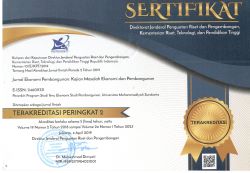Pandemic Shock and Economic Variables Responses in ASEAN Countries Using Panel Vector Autoregressive Model
Nora Ria Retnasih(1*), Yulia Maris Herdianti(2)(1) UIN Maulana Malik Ibrahim Malang
(2) UIN Sayyid Ali Rahmatullah Tulungagung
(*) Corresponding Author
Abstract
This quantitative research aims to measure the factors that affect the economy in 10 ASEAN countries in 2014-2020. The method used is panel vector autoregressive (PVAR). The results of the research were divided into several tests. First, the causality test shows that GDP has an effect on inflation and money supply with a one-way causality. Second, the PVAR test shows that the money supply has a significant effect on inflation and unemployment rate at lags 1 and 2. The follow-up test, namely IRF, shows that the shocks of GDP responded by all economic variables are greater than shocks to other variables. While the results of the VD test show that GDP is the largest contributor to the variation in the value of all economic variables studied, both in the short and long term.
Keywords
Full Text:
PDFReferences
Abidin, N. Z., Yussof, I., & Karim, Z. A. (2020). Total factor productivity shock and economic growth in selected asean+3 countries: A new evidence using a panel var. International Journal of Business and Society, 21(3), 1366–1383.
Abrigo, M. R. M., & Love, I. (2016). Estimation of panel vector autoregression in Stata. Stata Journal, 16(3), 778–804. https://doi.org/10.1177/1536867x1601600314
Adam, C., Henstridge, M., & Lee, S. (2020). After the lockdown: Macroeconomic adjustment to the COVID-19 pandemic in sub-Saharan Africa. Oxford Review of Economic Policy, 36(May), S338–S358. https://doi.org/10.1093/oxrep/graa023
Agirkaya, M. B., Koca, Z., & Ugan, A. A. (2021). The impact of Covid-19 on the economy of selected Asian countries. Estudios de Economia Aplicada, 39(10), 1–20. https://doi.org/10.25115/eea.v39i10.5736
Ahmad, K., Khalil, S., & Riaz, U. (2014). Inflation, Inflation Uncertainty and Economic Growth Nex- us in Pakistan: A Granger Causality Test. Inte Rnational Journal of Management Research and Emerging Sciences, 3(1), 24–36.
Akay, E. Ç., Oskonbaeva, Z., & Bülbül, H. (2020). What do unit root tests tell us about unemployment hysteresis in transition economies? Applied Economic Analysis, 28(84), 221–238. https://doi.org/10.1108/AEA-05-2020-0048
Anggraini, D. E., Riyanto, W. H., & Suliswanto, M. S. W. (2020). Analysis of Economic Growth in Asean Countries. Jurnal Ekonomi Pembangunan, 18(01), 80–90.
Antoni, A. (2015). The dynamic relationship between money supply and economic growth. Economic Journal of Emerging Markets, 7(2), 78–92. https://doi.org/10.20885/ejem.vol7.iss2.art2
Birinci, T., & Kirikkaleli, D. (2021). Modeling broadband, mobile telephone and economic growth on a macro level: Empirical evidence from G7 countries. Accounting, 7(4), 837–844. https://doi.org/10.5267/j.ac.2021.1.025
Bozkurt, C. (2014). Money, inflation and growth relationship: The Turkish case. International Journal of Economics and Financial Issues, 4(2), 309–322.
Chaitip, P., Chokethaworn, K., Chaiboonsri, C., & Khounkhalax, M. (2015). Money Supply Influencing on Economic Growth-wide Phenomena of AEC Open Region. Procedia Economics and Finance, 24(July), 108–115. https://doi.org/10.1016/s2212-5671(15)00626-7
Chia, S. Y. (2013). The ASEAN Economic Community: Progress, Challenges, and Prospects (Issue 440). https://doi.org/10.1007/978-1-349-67278-3_116
Cili, M. R., & Alkhaliq, B. (2022). Economic Growth and Inflation: Evidence from Indonesia. Signifikan: Jurnal Ilmu Ekonomi, 11(1), 145–160. https://doi.org/10.15408/sjie.v11i1.19848
Gnangnon, S. K. (2022). Effect of Structural Economic Vulnerability on the Participation in International Trade. Journal of Risk and Financial Management, 15(9). https://doi.org/10.3390/jrfm15090417
Hicham, A. (2020). Money Supply, Inflation and Economic Growth: Co-Integration and Causality Analysis. Studia Universitatis Babes-Bolyai Oeconomica, 65(2), 29–45. https://doi.org/10.2478/subboec-2020-0008
Ihsan, I., & Anjum, S. (2013). Impact of Money Supply (M2) on GDP of Pakistan. Global Journal of Management and Business Research Finance, 13(6), 2249–4588.
Inam, U. (2014). Money Supply and Economic Growth in Nigeria : An Econometric Analysis (1985-2011 ). Journal of Economics and Sustainable Development, 5(12), 149–156.
Jain, M. P., Sharma, A., & Kumar, M. (2022). Recapitulation of Demand-Pull Inflation & Cost-Push Inflation in An Economy. Journal of Positive School Psychology, 6(4), 2980–2983. http://journalppw.com
Kaur, P., Stoltzfus, J., & Yellapu, V. (2018). Descriptive statistics. Biostatistics, 4(1), 60–63. https://doi.org/10.4103/IJAM.IJAM
Lisani, N., Masbar, R., & Silvia, V. (2020). Inflation-Unemployment Trade-Offs In ASEAN-10. Signifikan: Jurnal Ilmu Ekonomi, 9(2), 241–256. https://doi.org/10.15408/sjie.v9i2.16346
Lopez, L., & Weber, S. (2017). Testing for Granger causality in panel data. Stata Journal, 17(4), 972–984. https://doi.org/10.1177/1536867X1801700412
Mahadika, H., & Wibowo, W. (2021). the Effect of Monetary Policy on Unemployment Rate in Indonesia. Jurnal Ilmu Ekonomi Terapan, 6(1), 1. https://doi.org/10.20473/jiet.v6i1.27100
Mandel, D. C., & Liebens, P. (2019). The Relationship between GDP and Unemployment Rate in the U.S. International Journal of Business and Social Science, 10(4), 17–24. https://doi.org/10.30845/ijbss.v10n4p3
Masnan, F., Shaari, M. S., & Hussain, N. E. (2013). Relationship among Money Supply, Economic Growth and Inflation: Empirical Evidence from Three Southeast Asian Countries. International Journal of Information, Business, Anf Management, 5(3), 83–96.
Michael, E. O., Emeka, A., & Emmanuel, E. N. (2016). The Relationship between Unemployment and Economic Growth in Nigeria : Granger Causality Approach. Research Journal of Finance and Accounting, 7(24), 153–162. www.iiste.org
Nagel, K. (2015). Relationships between unemployment and economic growth – the review (results) of the theoretical and empirical research. Journal of Economics and Management, 20(2), 65–79.
Ofori, C. F., Danquah, B. A., & Zhang, X. (2017). The Impact of Money Supply on Inflation, A Case of Ghana. Imperial Journal of Interdisciplinary Research (IJIR), 3(1), 2312–2318.
Qin, Y. (2020). No TitlThe Relationship Between Unemployment and Inflation-Evidence From U.S. Economy e. Advances in Economics, Business and Management Research, 159, 157–162.
Sahnoun, M., & Abdennadher, C. (2019). Causality Between Inflation, Economic Growth and Unemployment in North African Countries. Economic Alternatives, 25(1), 77–92.
Sebastine, A. I., Fagbile, S., & Nnamdi, A. C. (2016). Innovation, Impulse-Response Function Analysis of Money Supply and Real Money Balances in the Era of Financial. The Association of African Young Economist Policy Research, 16, 1–17.
Sigmund, M., & Ferstl, R. (2018). Panel Vector Autoregression in R with the Package Panelvar. SSRN Electronic Journal, January 2017. https://doi.org/10.2139/ssrn.2896087
Sulistiana, I., Hidayati, & Sumar. (2017). Model Vector Auto Regression (Var) and Vector Error Correction Model (Vecm) Approach for Inflation Relations Analysis, Gross Regional Domestic Product (Gdp), World Tin Price, Bi Rate and Rupiah Exchange Rate. Integrated Journal of Business and Economics, 1(2), 17–32. https://doi.org/https://doi.org/10.5281/zenodo.1147673
Sumaryoto, Nurfarkhana, A., & Anita, T. (2021). The Impact Of Money Supply And The Inflation Rtae On Indonesia Stock Exchange 2008-2017. International Journal of Economics, Business and Accounting Research (IJEBAR), 5(2), 196–213. https://jurnal.stie-aas.ac.id/index.php/IJEBAR
Taiwo, A., & Olayemi, S. O. O. (2015). Re-examine foreign direct investment and economic growth: Panel co-integration and causality tests for sub-Saharan African countries. International Area Studies Review, 18(1), 73–86. https://doi.org/10.1177/2233865914554469
Wu, X., Zhang, Z., Chang, H., & Huang, Q. (2021). A Data-Driven Gross Domestic Product Forecasting Model Based on Multi-Indicator Assessment. IEEE Access, 9, 99495–99503. https://doi.org/10.1109/ACCESS.2021.3062671
Wulandari, D., Utomo, S. H., Narmaditya, B. S., & Kamaludin, M. (2019). Nexus between inflation and unemployment: Evidence from Indonesia. Journal of Asian Finance, Economics and Business, 6(2), 269–275. https://doi.org/10.13106/jafeb.2019.vol6.no2.269
Yuliadi, I., & Yudhi, W. S. A. (2021). Economic Growth Determinants of Asean Economic Community: Feasible Generalized Least Square Approach. E3S Web of Conferences, 316, 01019. https://doi.org/10.1051/e3sconf/202131601019
Zhao, H. (2021). Is There a Stable Relationship between Money Supply and Price Level? Arguments on Quantity Theory of Money. Interdisciplinary Journal: Volume, 5(1), 13–18.
Zuhroh, I., Kusuma, H., & Kurniawati, S. (2018). An Approach of Vector Autoregression Model for Inflation Analysis in Indonesia. Journal of Economics, Business & Accountancy Ventura, 20(3), 261–268. https://doi.org/10.14414/jebav.v20i3.1019
Article Metrics
Abstract view(s): 464 time(s)PDF: 774 time(s)
Refbacks
- There are currently no refbacks.
















